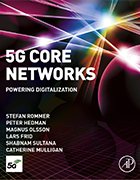5G for enterprises requires other tech to reap full benefits
5G for enterprises promises myriad benefits, but it won’t meet enterprises’ high expectations without other technologies.
5G has taken center stage in the telecommunications and networking industries, but it must share the spotlight to be successful. 5G’s costars include automation and 4G LTE, according to author Cathy Mulligan, as both will be essential for 5G to provide the higher network speeds and low latency it is capable of. Both automation and 4G LTE will help enable a broader ecosystem of speed and connectivity with 5G for enterprises.
In the book 5G Core Networks Editor’s note: The following interview was edited for length and clarity.
What should IT pros know about 5G for enterprises?
Cathy Mulligan: The first thing is integrating 5G networks and capabilities of the 5G network so end users can understand and make decisions on them in an enterprise environment. Second, behind the scenes, a lot of decisions will be made automatically. There will be a big link between 5G data streams and the automation back end of enterprise systems.
 Cathy Mulligan
Cathy Mulligan
There’s a need to understand data streams, data analysis, data analytics, etc., that we already know. A lot of decision-making processes and decision-making software are heavily automated behind the scenes, and lots of what we call ‘automation technologies’ now will be more advanced. Those systems, in today’s world, have IT systems in a manufacturing environment and then OT [operational technology] systems.
 Click here to learn more
Click here to learn more
about this book.
The integration of those two data streams will be important to 5G networks, and it has to be done on an IT integration level. Currently, within most companies, if you look at the way manufacturing is set up, employees [use IT services] separate from the OT systems run often In many instances across Europe, OT systems are owned and operated 5G will force [organizations] to fully take on automation. We see automation becoming more important as employees and companies are overloaded with data.
What won’t 5G do that organizations may think it will?
Mulligan: It’s not going to solve all your problems. That’s a bit facetious, but it’s the same with any new technology.
Unlike previous generations, [5G is] not going to completely replace 4G. There will still be a place for 4G. I’m also deeply skeptical about some use cases put forward around 5G. There’s not going to be this mystical thing to enable self-driving cars. I doubt the ability of 5G to do that.
It can contribute to that, but this is the big difference between 4G and 5G: 5G is a technology that has to be used in conjunction with other technologies across a bigger ecosystem to be of real use — unless you’re doing broadband replacement. Australia, for example, has done a lot around broadband replacement because it’s much cheaper to deliver using 5G.
Will 5G be an asset to remote work?
Mulligan: Technologies like 5G will be extremely useful in this new type of work we’re moving into. We’re going towards hybrid working models, so we will be working from home a lot [and] the office occasionally. What 5G will enable is a move towards more hybrid working models where you will be able to work more effectively.
During periods of time where I’ll be working from home, I’d also want to work from places like coffee shops. 5G would be critical for that because of the connectivity speed. We would have to make sure we had enough coverage; otherwise, it will be a bit patchy. But that’s the sort of thing 5G could be extremely useful for because 4G won’t cut it.
Can you compare current 4G capabilities to projected goals for 5G enterprise networks?
Mulligan: In some instances, it will be much higher speeds, much lower latency and, depending on how the small cell is configured, much higher bandwidth.
[One big] difference between 4G and 5G is 5G systems also provide a much higher level of abstraction, which allows you to simplify network operations but [also] move towards a programmable software-based style of networks. If we think about it from an end-user perspective, that gives you services on demand and in a web-style manner on the mobile network.
[Another] big change is the majority of technologies will be utilized Nonhuman interaction is the biggest difference. Truly, 5G is about the enterprise. It’s not about the human. 5G is about efficiency for things like manufacturing, enterprise solutions for retail and healthcare in a faster, better, more secure fashion rather than what an end user can do with an application.
It’s the difference between app integration or delivery on a mobile device and an actual, full enterprise integration you need to deliver a service for a company.
